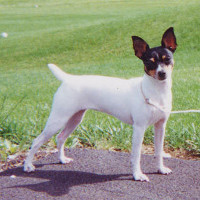Appearance of the Foxker
|
| The Foxker is a medium-sized hybrid breed developed from the American Cocker Spaniel and the Toy Fox Terrier. Its fine, wavy coat contains fluffy legs, torso, ears and tail. Its long, straight legs run parallel to its body. This happy dog has large paws with dark, black nails. The Foxker's ears are fluffy and wavy. Its coat comes in various color combinations such as brown, buff, black, parti and white with black or brown patches. This sometimes scruffy dog often has a body that's longer than it is tall. This hybrid has dark, bulging but alert eyes and a snub black nose. His expression is always friendly and curious. |
Temperament of the Foxker
|
| The Foxker is often described as a gentle, medium-sized breed with a huge heart. This intelligent dog prefers to spend time with his family and accompany children around the yard. Its loving nature is always present as long as it is not provoked. This breed will generally maintain good relationships with other dogs, but will require early training and socialization to become fully welcoming to other dogs. The Foxker is wary of strangers and may not accept them too positively, so training and the chance to interact regularly with people he doesn't know will help him feel at ease. Training your Foxker can be tedious and require more patience and time, so keep it interesting and be prepared to give him a break when he's had enough. This will make the sessions more interesting for everyone involved. Always ensure that training sessions with children and other pets are carried out under adult supervision to avoid any risk of injury to your Foxker, or to the children or other pets in the family. |
Needs and activities of the Foxker
|
| The Foxker has a moderate energy level. Interact with fun physical activities for a minimum of 30 to 40 minutes a day. Walking around the neighborhood is a good way for him to meet new people and other dogs, as is a visit to the park's dog run. He can be a good running partner as long as the activity isn't too long and takes place in the cooler part of the day. He may be keen to try agility, and obedience classes should always be part of a young dog's training. He adapts to all living environments in the home, so if he has access to a yard, keep an eye on him at all times, as he may try to dig his way out just for fun. |
Maintenance of the Foxker
|
| The Foxker is not considered a hypoallergenic breed and will shed moderately throughout the year. Brush its coat for 10 to 15 minutes daily with a stiff bristle brush and a greyhound comb, to remove dead hairs. We recommend bathing your dog every 6 to 8 weeks. This hybrid will require regular grooming due to its medium-length coat. Professional grooming should be provided every 4 to 6 weeks to avoid a scruffy dog with mats. Trimming may be necessary on legs, feet and ears. If you brush his teeth several times a week, you should be able to avoid excessive dental bills that could result from neglected gums and teeth. Check the length of his nails several times a month. This hybrid can be prone to ear infections if it has floppy ears that inhibit air circulation, so check them often for excess moisture or the presence of dirt. |









 English (United Kingdom)
English (United Kingdom)